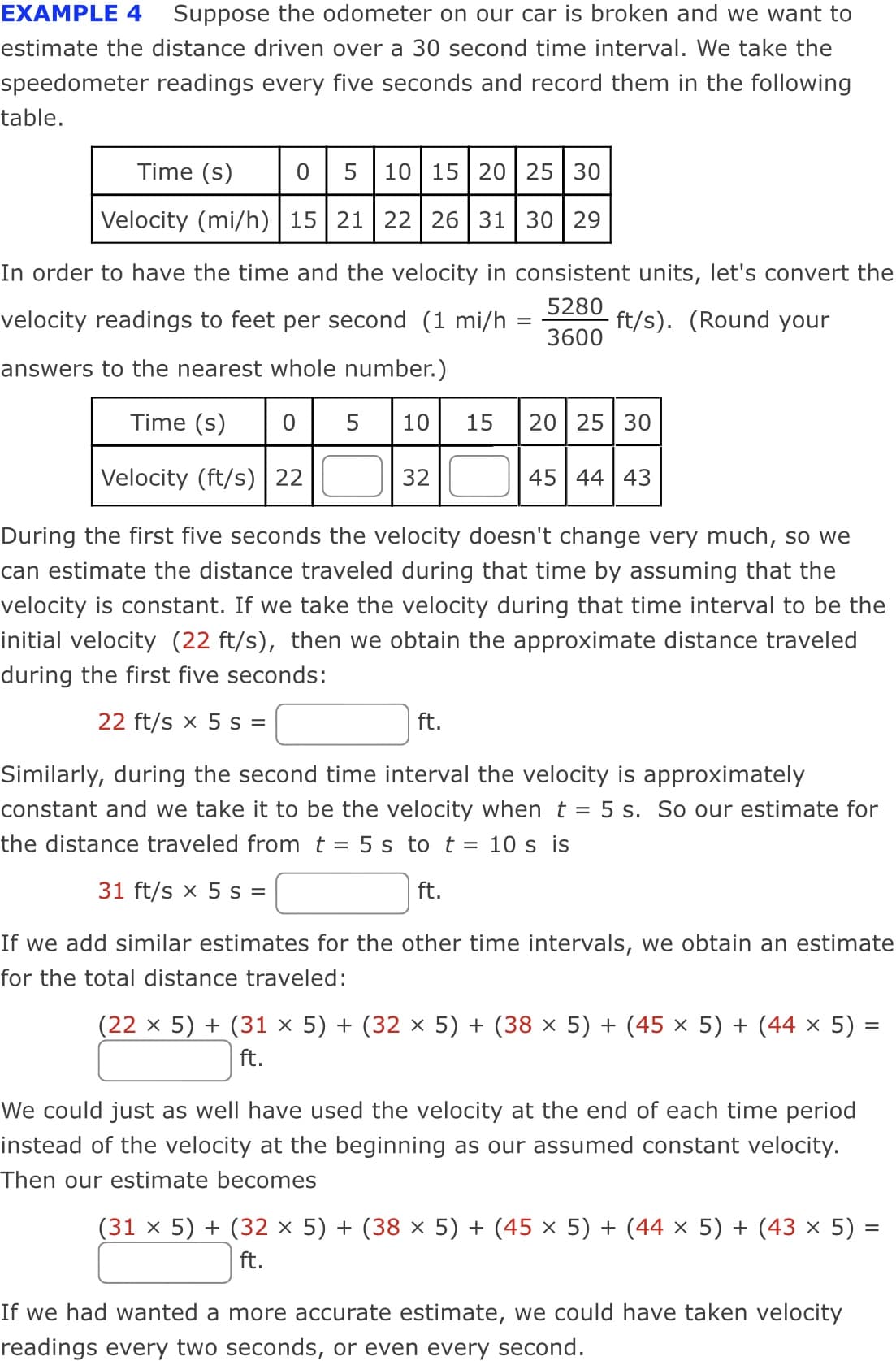Chapter6: Exponential And Logarithmic Functions
Section6.8: Fitting Exponential Models To Data
Problem 3TI: Table 6 shows the population, in thousands, of harbor seals in the Wadden Sea over the years 1997 to...
Related questions
Question

Transcribed Image Text:EXAMPLE 4 Suppose the odometer on our car is broken and we want to
estimate the distance driven over a 30 second time interval. We take the
speedometer readings every five seconds and record them in the following
table.
Time (s)
5 10 15 20 25 30
Velocity (mi/h) | 15 21 22 26 31 30 29
In order to have the time and the velocity in consistent units, let's convert the
5280
velocity readings to feet per second (1 mi/h
ft/s). (Round your
3600
answers to the nearest whole number.)
Time (s)
5
10
15
20 25 30
Velocity (ft/s)| 22
32
45 44 43
During the first five seconds the velocity doesn't change very much, so we
can estimate the distance traveled during that time by assuming that the
velocity is constant. If we take the velocity during that time interval to be the
initial velocity (22 ft/s), then we obtain the approximate distance traveled
during the first five seconds:
22 ft/s x 5 s =
ft.
Similarly, during the second time interval the velocity is approximately
constant and we take it to be the velocity when t = 5 s. So our estimate for
the distance traveled from t = 5 s to t = 10 s is
31 ft/s x 5 s =
ft.
If we add similar estimates for the other time intervals, we obtain an estimate
for the total distance traveled:
(22 x 5) + (31 × 5) + (32 × 5) + (38 × 5) + (45 × 5) + (44 × 5) =
%3D
ft.
We could just as well have used the velocity at the end of each time period
instead of the velocity at the beginning as our assumed constant velocity.
Then our estimate becomes
(31 × 5) + (32 × 5) + (38 × 5) + (45 × 5) + (44 × 5) + (43 × 5) =
ft.
If we had wanted a more accurate estimate, we could have taken velocity
readings every two seconds, or even every second.
Expert Solution
This question has been solved!
Explore an expertly crafted, step-by-step solution for a thorough understanding of key concepts.
Step by step
Solved in 2 steps with 2 images

Recommended textbooks for you


Algebra & Trigonometry with Analytic Geometry
Algebra
ISBN:
9781133382119
Author:
Swokowski
Publisher:
Cengage

Linear Algebra: A Modern Introduction
Algebra
ISBN:
9781285463247
Author:
David Poole
Publisher:
Cengage Learning


Algebra & Trigonometry with Analytic Geometry
Algebra
ISBN:
9781133382119
Author:
Swokowski
Publisher:
Cengage

Linear Algebra: A Modern Introduction
Algebra
ISBN:
9781285463247
Author:
David Poole
Publisher:
Cengage Learning

Functions and Change: A Modeling Approach to Coll…
Algebra
ISBN:
9781337111348
Author:
Bruce Crauder, Benny Evans, Alan Noell
Publisher:
Cengage Learning